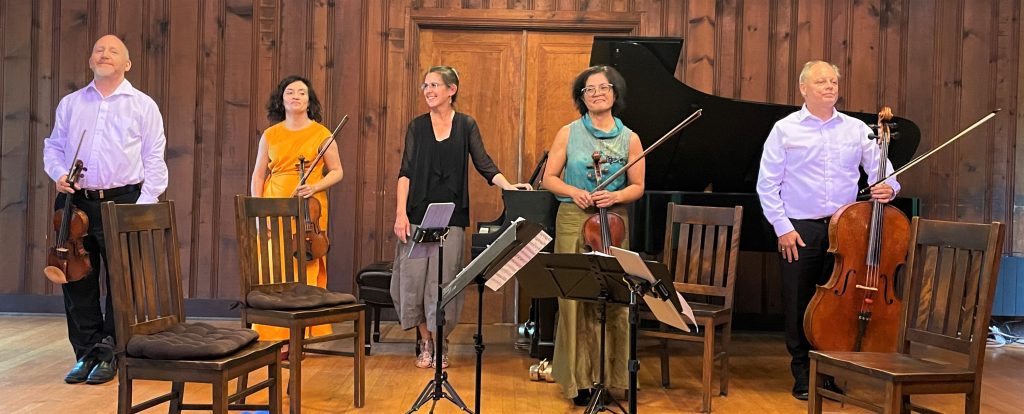
by Kevin T McEneaney
With a program that featured both old and recent compositions the Arianna Quartet delivered a powerful performance to a packed, appreciative audience on the mountaintop this past Sunday afternoon. Opening with String Quartet in E Flat Major, Op. 51 (1879) by Antonín Dvořák (nicknamed as Slavonic and judged to be one of the most excellent quartets ever written), they delivered with intense unity the composer’s signature sound with prominent cello role under the masterly fingers of Kurt Baldwin on cello, yet the composer was principally a violinist (and played organ, piano, and viola) and consequently violinist John McGrosso excelled in the leading strain with vigorous support from Joanna Mendoza on viola. This quartet is a Western style quartet with Slavic folk music undertones, which remain the foundation of the quartet. While the first and third movements are loose sonata’s, the middle movement is one of Dvořák’s most striking Dumkas, alternating between sadness and quiet satisfaction akin to the charming sunset quiescence with which the second movement concludes. The finale, a soothing Romanza, offers the promise of a mythological landscape that we all wish we could inhabit, and it gives the audience a taste of marvelous beatitude.

Leyendas: An Andean Walkabout for String Quartet (2001) by Gabriela Lena Frank (b. 1972) offered six movements on South American music. In the opening Toyos movement four classical instruments imitated various sounds parallel to the range of indigenous panpipe, which had the effect of translating traditional folk music into contemporary minimalism; this unusual approach was both shocking, innovative, and illuminating. Tarqueada likewise imitated sounds of the tarka, a heavy wooden duct flute blown harshly in order to split the tone; this was performed in such rapid fourths and fifths, producing an astonishing effect. Himno de Zampoñas imitated a chorus of zampoña panpipes; to get the effect of their rather flat sound, these four instruments delivered a multitude of double stops which offered a mischievous and amusing effect. Chasqui described the journey of fast-running indigenous messengers; to create this lighter, faster effect the sound of flute and strummed guitar were imitated (with Baldwin’s cello playing high notes). Canto De Veloria presented the sounds of professional indigenous funeral mourners, growing from one to a crescendo chorus with intricate, rapid picking of all four strig instruments to indicate guitar accompaniment—this surging movement was powerfully impressive, as it also celebrated mestizo culture by including the famous medieval Dies Irae chant. Concluding Coqueteos dramatized male romance singers ever growing into a larger chorus (again with fierce string picking that was astonishing). This finale produced the theme of love as an awesome wonder that transformed society to a higher level of awareness. It was a marvel to hear traditional Western instruments played in this manner; the difficulty of playing demanded extraordinary plucking!

After intermission pianist Judith Gorden joined the Quartet to perform Piano Quartet in E Flat Major, Op. 44 (1842) by Robert Schumann. This was the forty-second performance of this extraordinary work at Music Mountain. Mozart had developed the piano quartet, which was mostly about the piano leading a dialogue with instruments, yet Schumann’s piano quartets treated all instruments with equal status (and here Julia Sakharova on second violin had some brilliant runs), a conversation among peers—and that continued when invented the piano quintet that featured a far more complicated intertwining dialogue among all five instruments with Clara Wieck at the keyboard. The intermingling of the instruments with overlapping themes creates a dense and complicated labyrinth with the amusing joy of emerging from the forest thicket to wondrous sunlight with the piano as the delivering savior compass, this time under the flexible, emotionally expressive, effortless virtuosity, and assured fingering of Judith Gordon. The rising and falling themes in the Scherzo offer a disorientating roller coaster eventually displaced by a choice of two contrasting trios for the listener to choose. The Finale demands intense unity as it engages in explorations that appear to be exhausted, then with dramatic pause recalls the opening movement and explodes into a double fugue with the piano leading with intense strings in counterpoint that conjure a triumphant release that has pleased audiences for the past two centuries!
